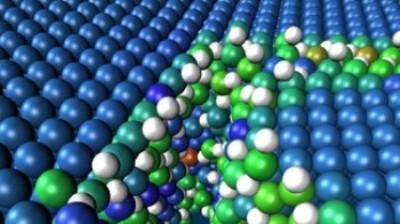Nov 22 2012
EPFL researchers have elucidated a century-old mystery: how hydrogen destroys steels. A new mathematical model predicts this failure in the presence of the destructive atoms.
 © 2012 EPFL
© 2012 EPFL
A veritable gangrene for steels and other structural metals, hydrogen is one of the most important causes of ruptures in industrial parts, such as pipelines. At the slightest defect in a material, these atoms introduce themselves in the crack and weaken the structure dramatically, making it brittle. The material need only be in contact with aggressive substances or placed in an aqueous environment from which for the dangerous hydrogen atoms enter the material. This phenomenon of "hydrogen embrittlement" has been known for many years, but so far no one managed to capture the physical process or predict when hydrogen embrittlement will occur. Bill Curtin of the Laboratory of Multiscale Mechanical Modeling at EPFL and his collaborator Prof. Jun Song at McGill, tackled this problem and developed a mathematical model to understand the behavior of hydrogen atoms in iron-based steels and thus to predict steel fracture. This is revolutionary in the world of materials, and serves as the subject of an article in the journal Nature Materials.
Hydrogen Attracted by Fractures
To establish their equation, the researchers studied the behavior of iron at the atomic level. They showed that the reason hydrogen weakens the materials comes from the tendency of hydrogen atoms to cluster at the tip of a crack. "In the absence of hydrogen, dislocation defects form around a crack, allowing it to relax the stress in the material and preventing the crack from growing, making the material more resilient or tougher, explained Bill Curtin. By grouping around the crack, the hydrogen atoms prevent the creation of these dislocations, and prevent the stress relaxation, allowing the crack to grow and the material becomes extremely brittle."
A mathematical model that predicts the fracture
Using their simulations, the scientists were able to establish a complex mathematical model that calculates when a material in contact with hydrogen will start to break. Several factors are taken into account, such as the concentration of hydrogen in the environment, the speed at which the hydrogen molecules move toward the crack, type of steel, and the load on the structure. If a combination of these parameters attains a critical value, computed from the simulations, then the material will break. Using the model, they predicted the breaking point for a various steels under various conditions. "Our predictions coincided with the experiments in 9 out of 10 cases, rejoiced Bill Curtin. And the 10th case was right on the border".
This knowledge should allow scientists to tackle the problem armed with new weapons. It will become easier to identify adverse operating modes and to construct materials that are more resistant to this type of deterioration.